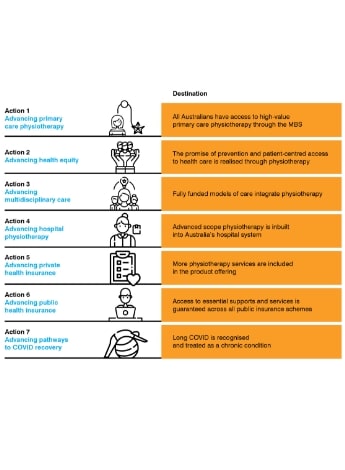
White paper lays out transformative reform path

APA National President Scott Willis considers the APA’s upcoming white paper, Future of Physiotherapy in Australia, which calls for comprehensive reform and outlines seven detailed actions to bring it about.
Where to for reform?
The past decade of policy drift has meant there’s been little to no progress towards creating the value-based healthcare system we need.
What we are seeing now in Australia’s health reform challenge is a key policy moment for physiotherapy and the wider health system—not only because of the pandemic, but as the culmination of a protracted period of reform discussion.
This has left us with so many plans, which now need to coalesce into a single reform vision for the health system.
We must move beyond a perpetual planning state.
Otherwise, healthcare will continue to be unaffordable, inaccessible and of variable quality.
The new Albanese government is setting us back on the reform path in what now presents as an unprecedented opportunity to transform the healthcare system.
As we begin this reform journey, in addition to a shared vision we need the policy courage to move from vison to action.
We need to address the disruption caused by the pandemic with an immediate focus on restoring services, but we must also ensure that we activate this shift towards ‘renewal’ by creating the systems needed to enable high-value healthcare.
In making that transition, we need to see more rather than less investment in primary care and in the community as well as at the acute care interface and in hospital-based care.
This will require significant reform of the organisation and delivery of healthcare.
The APA will soon publish a white paper, Future of Physiotherapy in Australia—a 10-year vision policy paper.
We call for action at national, state and local levels to deliver improvements in population health through value-creating solutions encompassing physiotherapy.
In recent years, the APA has played a strong role in the national reform process, including shaping Australia’s Primary Health Care 10-Year Plan 2022–2032.
Building on this work, our commitment to reform remains ambitious and far-reaching to ensure that all Australians have access to physiotherapy.
To tackle immediate and emerging challenges, we have identified a suite of actions, set out in a 10-year vision, to strengthen our advocacy so that the full benefits of physiotherapy can be realised.
A framework for action
We have outlined seven actions in our framework, from advancing primary care to navigating our way out of COVID-19.
Through these actions, we have the opportunity to deliver better health outcomes and to provide a path to better care by fully using the physiotherapy workforce.
Here, we unpack the seven key action points designed to advance physiotherapy and strengthen care for all Australians.
Our vision is to ensure that all Australians have access to publicly funded physiotherapy.
In Action 1, ‘Advancing primary care physiotherapy’, we outline a path to better care that optimises the patient journey by removing current structural barriers and investing more in public physiotherapy.
We call for renewal of the Medicare system through investment in publicly funded first contact physiotherapy.
We call for better access to chronic disease and pain items and for the expansion of preventive and restorative healthcare through new physiotherapy-led models.
At the heart of the changes is restoring fairness to achieve more equitable health outcomes for priority population groups.
In Action 2, ‘Advancing health equity’, we set the fair foundations we need for health equity and access.
The first step involves gaining access to affordable healthcare.
There’s a two-speed health system—those who can cover their health costs with their own money and those who can’t.
It doesn’t have to be that way.
The shift from reactive models to preventive healthcare is essential.
We need to pick up the pace through the accelerated establishment of new preventive healthcare models across priority populations who are the most at risk of poor health outcomes.

The APA's new white paper, Future of Physiotherapy in Australia, outlines seven actions to deliver better health outcomes.
It is these priority populations, including Aboriginal and Torres Strait Islander peoples, people from a low socio-economic background, culturally and linguistically diverse populations, people living in remote areas and people living with disability, that stand to benefit the most from physiotherapy-led prevention.
In ‘Advancing multidisciplinary care’, Action 3, we outline new approaches to funding team-based care in order to deliver the best health and system outcomes.
This remains a central reform challenge in Australia.
For integration to be successful, a commitment to funding greater access to physiotherapy and multidisciplinary care that encompasses the entire health workforce is vital.
Fully funded and integrated models are needed across the health system, with a focus on aged care and cancer care and on formalising funding between physical and mental healthcare.
Primary Health Networks remain key to driving this shift but require dedicated funding, beyond their limited discretionary allocation, for new team-based collaborative models.
In Action 4, ‘Advancing hospital physiotherapy’, we outline ways to secure significant benefits to patients and the healthcare system.
We call for new pathways that maximise the contribution of physiotherapists in inpatient, outpatient and community-based services, in both private and public hospitals.
This is where significant gains can be realised; supporting physiotherapists to work at the top of their scope can address current inefficiencies in the hospital sector.
Advanced practice physiotherapists provide a solution to current workforce pressures and future reform must ensure that these roles are prioritised and developed nationally.
New policy paths towards private health insurance reform need to offer more value.
We need to see a reform plan where preventive strategies and management of chronic conditions feature strongly alongside a healthy ageing offering.
In Action 5, ‘Advancing private health insurance’, we call for a commitment to preventive strategies, home-based care solutions and addressing the lack of continuity of care for complex conditions.
Ways to increase the benefit of physiotherapy in providing vital care for priority populations are outlined in Action 6, ‘Advancing public health insurance’.
Some of the most important areas of care fall within a group of public health insurance areas supporting those with disability, our veterans and those affected by workplace injuries.
These schemes have proven that they significantly improve lives.
Physiotherapists are key participants in providing this vital care and we call for policy leadership to provide certainty of funding based on need and genuine choice on how needs are met.
This includes a commitment to consistent approaches to funding and pricing.
In Action 7, ‘Advancing pathways to COVID recovery’, we outline the critical role of physiotherapists in helping COVID-19 patients navigate their recovery.
We expect COVID to cast a long shadow, with increased pressure on our health system in the years to come.
We still have a lot to learn about long COVID, but the focus now needs to turn to supporting patients through their COVID recovery.
Our road map back to health will require a strong health workforce response, leveraging physiotherapy to accelerate our recovery.
We call for the development of a long COVID rehabilitation pathway that includes investment in publicly funded physiotherapy to drive new models of care.
From vision to action
As we enter this next phase of reforms, physiotherapy will be key to putting high-value care to action in Australia.
Now is the time to prioritise the critical issues and structural changes that matter most as we transition to value-based healthcare.
In forging a realistic path to healthcare reform in Australia, we have set solutions to connect and integrate care to deliver the four outcomes governments and patients want—high-value care, reduced costs, improved efficiency and giving patients enhanced ownership of their own healthcare.
I encourage all members to get behind our vison and participate in the policy discussion to ensure a strong voice for physiotherapy in reform.
© Copyright 2025 by Australian Physiotherapy Association. All rights reserved.





